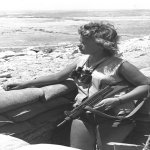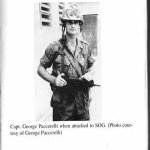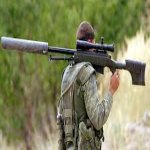You are using an out of date browser. It may not display this or other websites correctly.
You should upgrade or use an alternative browser.
You should upgrade or use an alternative browser.
Picture of the day
- Thread starter jwhc
- Start date
did these two pilots actually believe that the proper ‘tactic’ was to ‘make a steep dive’ to get ‘under’ a barrage balloon?!?!https://www.royalnavy.mod.uk/news-a.../january/30/150130-palembang-70th-anniversary
^Story about the Palembang raids & RN Avengers. The raid was a big operation with a lot of planning. The enemy were prepared. There were numerous barrage balloons above the target area. In addition the Avengers often had to provide their own fighter screen as for some of the sorties the Seafires were scrubbed due to the sea state.
This left the remaining Hellcats & Corsairs under a merciless workload trying to cover the bombers. In one case an Avenger pilot hosed down a green Japanese pilot in his machine at close range with the two fwd firing guns resulting in the Avenger being pelted with debris.
Possibly the same pilot watched two other Avengers fly into barrage balloon wires one after the other - they had to make steep dives to get under the balloons. Said it made him quite angry to see his fellows make these fatal errors.
In all the raid reminds me of the stories about the Romanian bombing missions even though it was a much smaller operation than the USAAF raids.
fat tony
CGN Ultra frequent flyer
did these two pilots actually believe that the proper ‘tactic’ was to ‘make a steep dive’ to get ‘under’ a barrage balloon?!?!
You could look it up on armouredcarriers.com. I suppose it could be a fabrication - bloggiverse and all. It seemed to be well researched. Nicely put together site. Previously I had only looked up the mobile version - the desktop version is even better.
Last edited:

Fredericton airport 1990, looking out my living room window
the NB forestry service used Avengers for fire fighting.
that explains my hearing loss.
They were also used for spraying for spruce budworm in the early 70's. I can personally attest to this as I got "sprayed" while doing geochemistry in the Miramichi area. The spray was a white powder, likely DDT...
Just like RCN reserve divisions named after ships.
I joined the CAF at HMCS Unicorn in Saskatoon Sask!
Gee, an engine visible in the burning wreck! Producers of "Dunkirk" please take note .....
Gee, an engine visible in the burning wreck! Producers of "Dunkirk" please take note .....
Yes. That scene was painful, wasn't it?
I wonder who got the trophy off the tail for their man cave?
Avengers were used as long term retardant fire bombers for many years. Capacity was 500 gals (I think!) Company named Hicks and Lawrence based at St Thomas A/P operated some for Ont MNR in 70's. I was working on a fire north of Thunder Bay and saw a drop. At the time I knew very little about warbirds and thought the A/C was a Harvard!!
Last edited:
Havent seen the scene (or the movie) but have it on pretty good authority that when one Mosquito made an unplanned landing the engines wound up a long way from the scene of the ‘accident’Gee, an engine visible in the burning wreck! Producers of "Dunkirk" please take note .....
Donny Fenn1
CGN Ultra frequent flyer
- Location
- East Kootenays
Attachments
Dark Alley Dan
CGN Ultra frequent flyer
- Location
- Darkest Edmonton
The last few minutes of Mr. Nguyen Van Lem's life:

...followed shortly by the famous (infamous?) photo of General Loan shooting him in the head.

...followed shortly by the famous (infamous?) photo of General Loan shooting him in the head.
South Vietnamese sources said that Lém commanded a Viet Cong insurgent team, which, on February 1, 1968, the second day of the Tet Offensive, had targeted South Vietnamese National Police officers, or in their place, the police officers' families. Corroborating this, Lém was captured at the site of a mass grave that included the bodies of at least seven police family members. Photographer Adams confirmed the South Vietnamese account, although he was only present for the execution. Lém's widow confirmed that her husband was a member of the Viet Cong and she did not see him after the Tet Offensive began.
Around 4:30 A.M., Lém led a sabotage unit to attack the Armor Camp in Gò Vấp. After communist troops took control of the base, Lém arrested Lieutenant Colonel Nguyen Tuan with his family and forced him to show them how to drive tanks.[2] When Lieutenant Colonel Tuan refused to cooperate, Lém killed Tuan, his wife and six children and his 80-year-old mother by cutting their throats. There was only one survivor, a seriously injured 10-year-old boy.[2]
Lém was captured amid fierce street fighting near a mass grave with 34 civilian bodies. Lém admitted that he was proud to carry out his unit leader's order to kill these people.[3]
Lém was brought to Brigadier General Nguyễn Ngọc Loan, Chief of the Republic of Vietnam National Police on Lý Thái Tổ street (10.765°N 106.68°E).[4] General Loan summarily executed Lém using his (Loan's) sidearm, a .38 Special Smith & Wesson Bodyguard revolver,[5] in front of AP photographer Eddie Adams[6] and NBC News television cameraman Vo Suu. The photograph and footage were broadcast worldwide, galvanizing the anti-war movement; Adams won a 1969 Pulitzer Prize for his photograph.
Military lawyers have not agreed whether Loan's action violated the Geneva Conventions for treatment of prisoners of war. As he appeared in the photo and footage, "Lem was in his shorts and shirt", and was not marked by any identifiable marker showing that he was a legal combatant;[2] nor was he, it is alleged, fighting enemy soldiers at the time, where POW status was granted independently of the laws of war; it was limited to Viet Cong seized during military operations
Around 4:30 A.M., Lém led a sabotage unit to attack the Armor Camp in Gò Vấp. After communist troops took control of the base, Lém arrested Lieutenant Colonel Nguyen Tuan with his family and forced him to show them how to drive tanks.[2] When Lieutenant Colonel Tuan refused to cooperate, Lém killed Tuan, his wife and six children and his 80-year-old mother by cutting their throats. There was only one survivor, a seriously injured 10-year-old boy.[2]
Lém was captured amid fierce street fighting near a mass grave with 34 civilian bodies. Lém admitted that he was proud to carry out his unit leader's order to kill these people.[3]
Lém was brought to Brigadier General Nguyễn Ngọc Loan, Chief of the Republic of Vietnam National Police on Lý Thái Tổ street (10.765°N 106.68°E).[4] General Loan summarily executed Lém using his (Loan's) sidearm, a .38 Special Smith & Wesson Bodyguard revolver,[5] in front of AP photographer Eddie Adams[6] and NBC News television cameraman Vo Suu. The photograph and footage were broadcast worldwide, galvanizing the anti-war movement; Adams won a 1969 Pulitzer Prize for his photograph.
Military lawyers have not agreed whether Loan's action violated the Geneva Conventions for treatment of prisoners of war. As he appeared in the photo and footage, "Lem was in his shorts and shirt", and was not marked by any identifiable marker showing that he was a legal combatant;[2] nor was he, it is alleged, fighting enemy soldiers at the time, where POW status was granted independently of the laws of war; it was limited to Viet Cong seized during military operations
Havent seen the scene (or the movie) but have it on pretty good authority that when one Mosquito made an unplanned landing the engines wound up a long way from the scene of the ‘accident’
In the movie "Dunkirk" a Spitfire makes a 'dead stick' beach landing (shooting down a German aircraft in the process) and the pilot torches the aircraft. As it burns, you see a prop shaft, but NO engine block! A little bit of an over sight in an already disjointed and f_cked up account of a massive military operation that kept Britain in the war.
South Vietnamese sources said that Lém commanded a Viet Cong insurgent team, which, on February 1, 1968, the second day of the Tet Offensive, had targeted South Vietnamese National Police officers, or in their place, the police officers' families. Corroborating this, Lém was captured at the site of a mass grave that included the bodies of at least seven police family members. Photographer Adams confirmed the South Vietnamese account, although he was only present for the execution. Lém's widow confirmed that her husband was a member of the Viet Cong and she did not see him after the Tet Offensive began.
Around 4:30 A.M., Lém led a sabotage unit to attack the Armor Camp in Gò Vấp. After communist troops took control of the base, Lém arrested Lieutenant Colonel Nguyen Tuan with his family and forced him to show them how to drive tanks.[2] When Lieutenant Colonel Tuan refused to cooperate, Lém killed Tuan, his wife and six children and his 80-year-old mother by cutting their throats. There was only one survivor, a seriously injured 10-year-old boy.[2]
Lém was captured amid fierce street fighting near a mass grave with 34 civilian bodies. Lém admitted that he was proud to carry out his unit leader's order to kill these people.[3]
Lém was brought to Brigadier General Nguyễn Ngọc Loan, Chief of the Republic of Vietnam National Police on Lý Thái Tổ street (10.765°N 106.68°E).[4] General Loan summarily executed Lém using his (Loan's) sidearm, a .38 Special Smith & Wesson Bodyguard revolver,[5] in front of AP photographer Eddie Adams[6] and NBC News television cameraman Vo Suu. The photograph and footage were broadcast worldwide, galvanizing the anti-war movement; Adams won a 1969 Pulitzer Prize for his photograph.
Military lawyers have not agreed whether Loan's action violated the Geneva Conventions for treatment of prisoners of war. As he appeared in the photo and footage, "Lem was in his shorts and shirt", and was not marked by any identifiable marker showing that he was a legal combatant;[2] nor was he, it is alleged, fighting enemy soldiers at the time, where POW status was granted independently of the laws of war; it was limited to Viet Cong seized during military operations
Thanks for this. I now understand why he got shot. He deserved it.
Adams felt that, by taking the photo, he had ruined Loan’s life. He felt Loan was a good man, in a bad situation, and he deeply regretted the negative impact that the photo had on him. In fact, Major General Loan later moved to the United States. When he arrived, the Immigration and Nationalization Services wanted to deport him partially because of the photo taken by Adams. They approached Adams to testify against Loan, but Adams instead testified in his favor and Loan was allowed to stay. When Loan died of cancer in 1998, Adams stated, “The guy was a hero. America should be crying. I just hate to see him go this way, without people knowing anything about him.”
A few months after the execution picture was taken, Loan was seriously wounded by machine gun fire that led to the amputation of his leg. Following the war, he was reviled where ever he went. After an Australian hospital refused to treat him, he was transferred to the United States, where he was met with a massive (though unsuccessful) campaign to deport him. In 1975, the former General, Nguyen Loan, opened a pizza parlor, which he ran until 1991, when his identity was discovered and he was forced to retire after receiving many threats.
ht tps://cherrieswriter.wordpress.com/2015/08/03/the-story-behind-the-famous-saigon-execution-photo/
The last few minutes of Mr. Nguyen Van Lem's life:

...followed shortly by the famous (infamous?) photo of General Loan shooting him in the head.
Note the ARVN trooper with the UZI smg, I would think the UZI was a rarely used by South Viet forces, usually carried by US VIP security detachment, correct me if I’m wrong on this
Note the ARVN trooper with the UZI smg, I would think the UZI was a rarely used by South Viet forces, usually carried by US VIP security detachment, correct me if I’m wrong on this
He is wearing ERDLs so he is likely the ARVN component of SOG. SOG procured in country made, tagless ERDL uniforms for sanitized missions. The other is wearing Tiger Stripes which in the ARVN makes him an ARVN Ranger graduate. Only elite units wore cammies in the ARVN.
MACV/SOG operators (AKA CIA)
Phoenix Program Operators (AKA CIA)
National Police RVN
VIP Escort US foreign Service
CIA owned 3000 UZIs most were used in Vietnam. Secret Service bought a number for VIP escort (Like the POTUS) in 70s. Modern Vietnam makes a copy for their national police.
1956

SOG

Attachments
Last edited:













































































